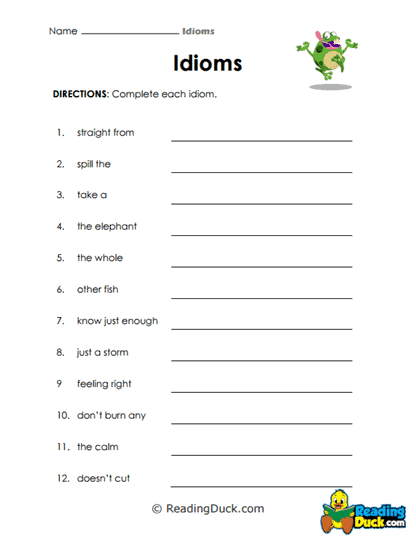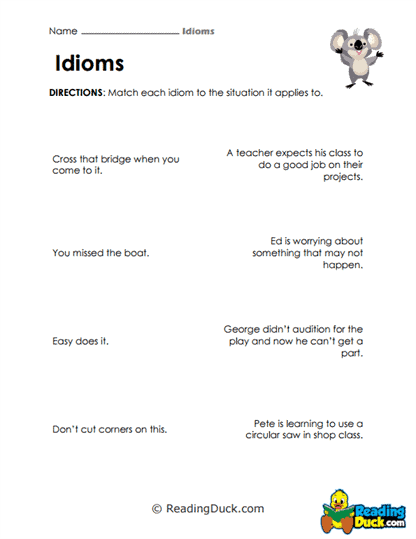Idioms Worksheets
About Our Idiom Worksheets
Our collection of Idioms Worksheets falls within the Language category in the Skills section. These worksheets are designed to help students master idioms—phrases or expressions that have figurative meanings different from the literal meanings of the individual words. Understanding idioms is essential for fluency in language, as idioms frequently appear in literature, conversations, and media. This collection introduces students to common idiomatic expressions, guiding them through the process of identifying, interpreting, and using idioms effectively. By mastering idioms, students develop deeper comprehension skills and become more versatile in both their writing and speaking.
The worksheets are available in PDF format, making them easy to view, download, and print for classroom or home use. Each worksheet comes with a downloadable answer key, ensuring that students and educators can assess progress efficiently and reinforce key concepts as needed.
What Are Idioms?
Idioms are phrases or expressions where the overall meaning is different from the literal meanings of the individual words. These figurative phrases are often tied to specific cultural or linguistic contexts, making them difficult for learners to grasp at first glance. Learning idioms is critical because they are frequently used in spoken and written language to convey ideas more creatively and vividly.
Key Features of Idioms
Figurative Meaning: The main characteristic of idioms is that their meaning cannot be deduced by simply understanding the individual words. Instead, the phrase as a whole takes on a figurative meaning.
-
- Example: "It’s raining cats and dogs." This doesn’t mean animals are falling from the sky; it means that it is raining very heavily.
Cultural Significance: Many idioms have cultural roots and may vary between languages or regions. Understanding the cultural context of idioms helps learners appreciate the richness of a language.
-
- Example: "Break the ice" refers to starting a conversation or easing tension in a social situation, but its origins are linked to ships breaking ice to forge a path.
Fixed Phrases: Idioms are often fixed phrases, meaning they don’t change structure easily. You wouldn’t say "break the glass" to mean "break the ice." The words and order of the idiom remain the same.
Idioms are widely used in English and other languages to express ideas colorfully and indirectly, which makes them important for students to master in order to navigate both casual conversations and more formal settings effectively.
Exploring the Different Uses of Idioms
Idioms serve a variety of functions in both written and spoken language. From adding humor to softening difficult topics, idioms allow speakers and writers to communicate in ways that are more expressive, creative, and engaging. Let’s look at how idioms are used in different contexts and what role they play in everyday communication.
Idioms in Everyday Conversation
In casual conversation, idioms help people express emotions, actions, or situations in a more interesting and relatable way. By using idioms, speakers can condense complex ideas into a simple, often colorful phrase that is easier for listeners to grasp.
- Example: "Hit the nail on the head."
- This idiom means to describe or identify something exactly. In conversation, it’s often used to express when someone’s understanding or explanation is perfectly accurate.
- Example: "Spill the beans."
- This phrase means to reveal a secret or disclose important information prematurely. It adds a playful tone to conversations where the speaker is discussing information that has been unintentionally shared.
Idioms in Literature
In literature, authors often use idioms to add depth to their characters' dialogue or to evoke a certain mood or tone. By using idiomatic expressions, writers can make dialogue sound more natural and bring characters to life, while also conveying cultural nuances or emotions in a subtle way.
- Example: "Let the cat out of the bag."
- Used in dialogue, this idiom means that someone has accidentally revealed a secret. An author might use it in a novel to show a character’s slip-up during a tense moment.
Idioms in Media and Advertising
In advertising, idioms are often used to make slogans more memorable or to create a sense of relatability. Because idioms are easily recognized, using them in marketing helps catch the audience’s attention and conveys a message quickly.
- Example: "The best thing since sliced bread."
- This idiom, meaning something is excellent or innovative, is often used in advertisements to emphasize the uniqueness or superiority of a product.
Idioms and Their Role in Literacy Skills
Mastering idioms plays a significant role in enhancing students' overall literacy skills. When students understand idioms, they can navigate more complex texts, participate in conversations more fluently, and express themselves more creatively. Let’s explore how learning idioms improves various aspects of literacy.
Boosting Reading Comprehension
Idioms frequently appear in literature, news articles, and other written forms. For students to fully understand the meaning of a text, they must be able to recognize idiomatic expressions and interpret their figurative meanings. Without this understanding, students may misinterpret the message or tone of a passage.
For example, a student reading the phrase "kicked the bucket" in a story might initially think of someone physically kicking a bucket, when the idiom actually means that someone has passed away. By learning common idioms, students develop better comprehension skills and can interpret texts more accurately.
Enhancing Writing Skills
In writing, idioms allow students to convey ideas with greater nuance and creativity. By incorporating idiomatic expressions into their writing, students can make their essays, stories, or reports more engaging. Idioms also help students vary their sentence structure and add color to their descriptions.
- Example: Instead of writing "He was very happy," a student might use the idiom "He was on cloud nine," which conveys the same emotion in a more expressive way.
Learning how to use idioms correctly enriches students' writing and gives them more tools to convey ideas vividly.
Improving Speaking and Listening Skills
In conversation, idioms are commonly used to express thoughts in a more familiar or informal way. Understanding idioms helps students follow conversations more easily, especially in social or cultural contexts where idiomatic expressions are used frequently. Furthermore, using idioms in speech enables students to sound more natural and fluent.
For instance, in a discussion about work, someone might say, "Let’s call it a day," meaning to stop working for the day. Recognizing this phrase helps students grasp the speaker’s intent, while using such idioms themselves helps them communicate more effectively.
Engaging Activities to Reinforce Idioms Learning
To help students fully grasp the meaning and usage of idioms, educators can introduce a variety of activities that make learning fun and engaging. These activities can be used in both school and homeschool settings, and they provide interactive ways for students to practice and reinforce their understanding of idiomatic expressions.
Creative Activities for Classrooms and Homeschooling
- Idioms Charades: Students can act out different idioms without using words, while their classmates guess the phrase. This activity encourages students to think creatively about how to express idioms visually, while reinforcing their understanding of each expression’s meaning.
- Idiom Illustrations: Have students draw a literal interpretation of an idiom (e.g., "raining cats and dogs") and then write its figurative meaning below the illustration. This visual exercise helps students understand the difference between the literal and figurative meanings of idiomatic expressions.
- Idiom Story Challenge: Encourage students to write a short story that incorporates at least five different idioms. This challenge helps students apply idiomatic expressions in context, reinforcing their understanding through creative writing.
- Idioms in Dialogue: Ask students to create a dialogue between two characters, using idioms to express emotions, actions, or opinions. This activity helps students practice using idioms in a conversational setting, enhancing both their speaking and listening skills.
These activities make learning idioms engaging and interactive, helping students solidify their understanding while enjoying the process.
Practical Importance of Idioms in Real Life
Idioms are not just a language exercise—they are a vital part of everyday communication. People use idioms regularly in conversations, media, and professional settings. Understanding idiomatic expressions allows students to participate more fully in social interactions, comprehend written texts more accurately, and express themselves with greater creativity.
In real-life applications, idioms are invaluable. Whether navigating informal conversations, reading news articles, or interpreting literature, students who understand idioms are better equipped to grasp the full meaning of what they encounter. Additionally, using idioms appropriately in writing or speech can make communication more engaging, persuasive, and effective.
In summary, mastering idioms is essential for students’ overall language development. This collection of Idioms Worksheets provides students with the tools they need to understand, interpret, and use idiomatic expressions confidently. By incorporating idioms into their vocabulary, students enhance their reading, writing, speaking, and listening skills, becoming more proficient and adaptable communicators in both academic and real-world settings.









